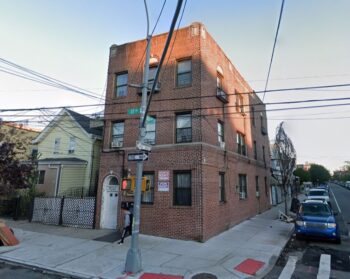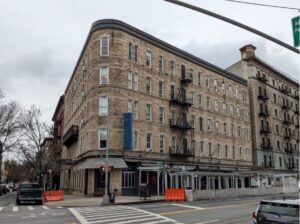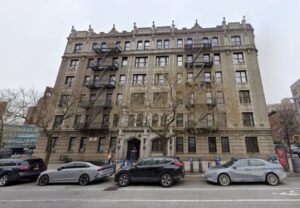
105-19 37th Avenue. Image Credit: Google Maps.
On April 4, 2023, the Landmarks Preservation Commission voted to calendar three buildings connected to the growth of jazz music; 105-19 37th Avenue in Corona, Queens, which served as the home for famous trumpeter Dizzy Gillespie; the Hotel Cecil & Minton’s Playhouse Building in Harlem; and 935 St. Nicholas Avenue in Hamilton Heights, which was the home of jazz legends Duke Ellington and Noble Sissle.
105-19 37th Avenue
Legendary jazz trumpeter John Birks “Dizzy” Gillespie lived at 105-19 37th Avenue in Corona for almost 14 years during the height of his career. Gillespie was known for his contributions to the growth and development of Afro-Cuban jazz, his work as a co-founder of the jazz style bebop with Charles Parker, and his iconic bent trumpet. Some of his famous compositions include “Groovin’ High,” ‘Salt Peanuts” and “A Night in Tunisia.” The U.S. State Department picked Gillespie to be the first jazz ambassador in 1956. As part of an effort to promote American culture and values during the Cold War, Gillespie’s 18-piece big band traveled around and performed in Europe, the Middle East and South America. An appearance on Edward R. Murrow’s Person to Person was broadcast live from Gillespie’s Corona home.
Gillespie purchased and moved into the three-story multi-family building at 105-19 37th Avenue in 1953. The building is in the Colonial Revival style and features simple facades of patterned red brick and cast-stone keystones and cartouches. The building’s original front and side doors and some windows have been replaced, but otherwise there have been minimal changes to the exterior from when Gillespie lived there. He moved to New Jersey in 1966, but retained ownership of the building until 1985.
Gillespie was recognized internationally for his contributions to jazz over his six-decade long career. In 1989, he was awarded the Grammy Lifetime Achievement Award. He passed away from pancreatic cancer in January 1993. He was inducted posthumously into the International Latin Music Hall of Fame in 2002.
Hotel Cecil & Minton’s Playhouse Building

The Hotel Cecil and Minton’s Playhouse building. Image Credit: LPC.
The Hotel Cecil & Minton’s Playhouse Building, located at 206 West 118th Street in Harlem is a five-story Renaissance Revival style building built in 1895-96. It was designed by Julius F. Munchwicz. The building features a grayish brick facade and offered furnished apartment suites for both long and short term stays.
The hotel is known for the legendary nightclub Minton’s Playhouse which operated in the hotel for over thirty years. The nightclub opened between 1938 and 1939 and was named after the club’s owner Henry Minton. The club’s house band played popular songs and featured guest singers and soloists like Charlie Christian, Roy Eldridge, Lester Young, Coleman Hawkins, and Ben Webster. The bebop style of jazz took shape in part at Minton’s, where artists like Dizzy Gillespie could experiment during open jam sessions the club held on Mondays. Gillespie had described his initial performances with the house band at Minton’s Playhouse as “wonderfully exciting.” The club continued to host jazz performances throughout the 1950s and 60s, including from groups led by Eddie Lockjaw Davis, Erroll Gardner, George Benson and Carmen McCrae. Over the years the club also attracted many Black musicians from other genres of music including blues, gospel, and soul.
The hotel was featured in the Negro Motorist Green Book, a popular guidebook for African American travelers, in consecutive editions from 1941 to 1961. The hotel was damaged by fire in 1974 and the club was closed. The building was listed on the National Register of Historic Places in 1985 and was sensitively refurbished. It reopened as supportive housing for homeless men and women in 1988. The building has approximately 89 residential units, office and commercial space. Currently, the building’s first floor is occupied by the Cecil Harlem restaurant and a jazz club restaurant named after Minton’s Playhouse.
935 St. Nicholas Avenue

935 St. Nicholas Avenue. Image Credit: Google Maps.
935 St. Nicholas Avenue is a Gothic Revival style brick and limestone apartment building on the corner of West 157th Street and St. Nicholas Avenue. It was designed by Gronenberg & Leuchtag in 1915 and remains architecturally intact. However, the building is more culturally significant as it was home to jazz legends Duke Ellington from 1939 to 1961 and Noble Sissle from 1950 to 1972. It retains a high degree of integrity of when it was built and during the period Ellington and Sissle lived there. In 1976, the building was added to the National Register of Historic Places in 1976.
Edward Kennedy “Duke” Ellington is known as one of America’s most prolific jazz orchestra leaders. His career started in New York in 1923 and continued until he passed away in 1974. Over his career, Ellington composed over 3,000 songs. During his time living at 935 St. Nicholas Ellington composed many famous jazz songs including “Sophisticated Lady,” “Satin Doll,” “Don’t Get Around Much Anymore,” and “I Let a Song Go Out of My Heart.” He also created music for film and television scores, and composed musical suites of pieces connected by subject matter. Some of these musical suites included “Black, Brown and Beige” in 1943 about African American history, and “A Drum is a Woman” in 1956. Ellington received many awards and accolades over his career, including the Grammy Lifetime Achievement Award in 1966 and the Presidential Medal of Freedom in 1969.
Nobel Lee Sissle moved to New York in 1916. In World War I, he served as a member of the 369th regimental band, part of the primarily African American regiment known as the “Harlem Hell Fighters.” His first musical with Eubie Blake, Shuffle Along, opened in 1921 and was the first successful Broadway musical with an all-Black cast. Sissle formed his own orchestra and toured the United States and Europe from the 1930s through the 1950s. He also appeared in movies and television shows. In 1937, Sissle founded the Negro Actors Guild of America, which worked to eliminate stereotyping of African American actors in their performances. He was president from 1937 to 1957. Duke Ellington served as the co-vice president of the Guild with Ethel Waters and Marion Anderson. Sissle also wrote many articles for the New York Age and the New York Amsterdam News. He had a radio show on local station WMGM from 1954 to 1971.
Landmarks voted to calendar both buildings and will hold public hearings at a future date.
By: Veronica Rose (Veronica is the CityLaw fellow and a New York Law School graduate, Class of 2018.)

